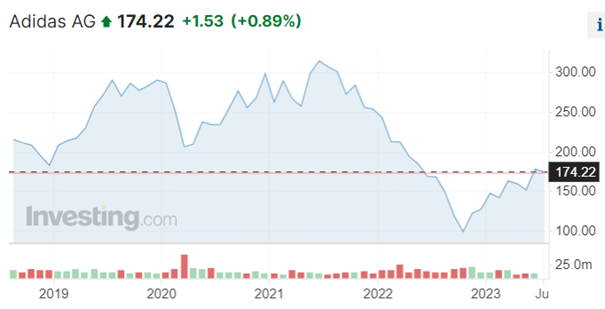Article said that Adidas has received orders exceedingly approximately 565 million USD for 4 million pairs of unsold Yeezy shoes, surpassing the company's most optimistic projections. The strong demand for the initial batch of online sales has potentially prevented the German sportswear company from taking a significant write-down on its remaining stock. After rapper Kanye West made a series of antisemitic comments, Adidas discontinued selling Yeezy shoes from its defunct partnership with him in October. The loss of the highly profitable line had a negative impact on the company's first-quarter sales, decreasing by around 440 million USD. Nevertheless, the robust demand for the unsold sneakers has alleviated concerns at Adidas' headquarters that Ye's outbursts and reduced marketing efforts in the recent past would have rendered the Yeezy brand too toxic.
So far so good. I have decided to check also what has been happening in the near past regarding Yeezy shoes. Article on Reuters wrote that in May, the company had announced its plan to contribute a portion of the sales proceeds to organizations combating antisemitism and racism. The specific allocation to individual charities is still under discussion, with Adidas having identified five charities in the United States and China as an initial step. The total amount donated from the sales is expected to be significantly higher as Adidas is prepared to allocate a substantial portion of the profits generated from the Yeezy inventory. Prior to announcing its intention to sell the remaining Yeezy stocks, Adidas had anticipated a loss for the current year.
As far as the stocks go, it looks quite promising, at least in my opinion. The price is currently at 174 EUR per stock, after the major correction, when it fell from 315 EUR to 99 EUR.* Company is also expected to announce financial report in the beginning of August. If they will be positive, I can expect the stock to have some momentum. Nevertheless, it has a lot of space for movement. [1]

Movement of Adidas stocks in the last five years. (Source: Investing) *
* Past performance is no guarantee of future results.
[1] Forward-looking statements are based on assumptions and current expectations, which may be inaccurate, or based on the current economic environment which is subject to change. Such statements are not guaranteeing of future performance. They involve risks and other uncertainties which are difficult to predict. Results could differ materially from those expressed or implied in any forward-looking statements.








